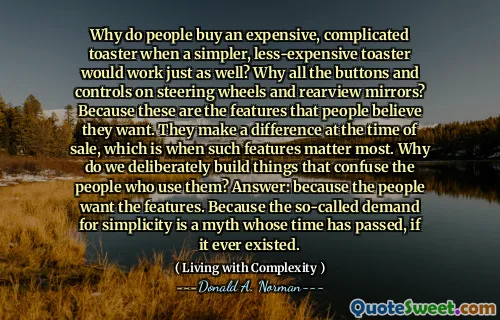
Why do people buy an expensive, complicated toaster when a simpler, less-expensive toaster would work just as well? Why all the buttons and controls on steering wheels and rearview mirrors? Because these are the features that people believe they want. They make a difference at the time of sale, which is when such features matter most. Why do we deliberately build things that confuse the people who use them? Answer: because the people want the features. Because the so-called demand for simplicity is a myth whose time has passed, if it ever existed.
This quote challenges the common assumption that simplicity is always preferable in product design. Often, designers and manufacturers add complex features and multiple controls not because users necessarily need or want them, but because marketing strategies position these features as desirable or innovative. This underscores a fundamental insight: people are attracted to products with apparent added value, even if those features complicate the use or increase cost without improving basic functionality. The perception of sophistication or high-end features can influence buying decisions more than practical usability. This reflects a broader societal tendency to equate complexity and abundance of features with quality, status, or progress, which can lead to end-user frustration and confusion. The quote makes me think about the importance of understanding actual user needs versus perceived needs driven by marketing or design trends. In many cases, simplicity in design doesn't mean a lack of features but a thoughtful balance that empowers users without overwhelming them. Ignoring these principles results in products that are more complicated than they need to be—highlighting a disconnect between what users claim they want and what truly benefits them. Navigating this challenge requires a deep understanding of user behavior, preferences, and the psychological factors influencing purchasing decisions, all of which are crucial for creating intuitive, user-centric products that genuinely enhance the user experience.






